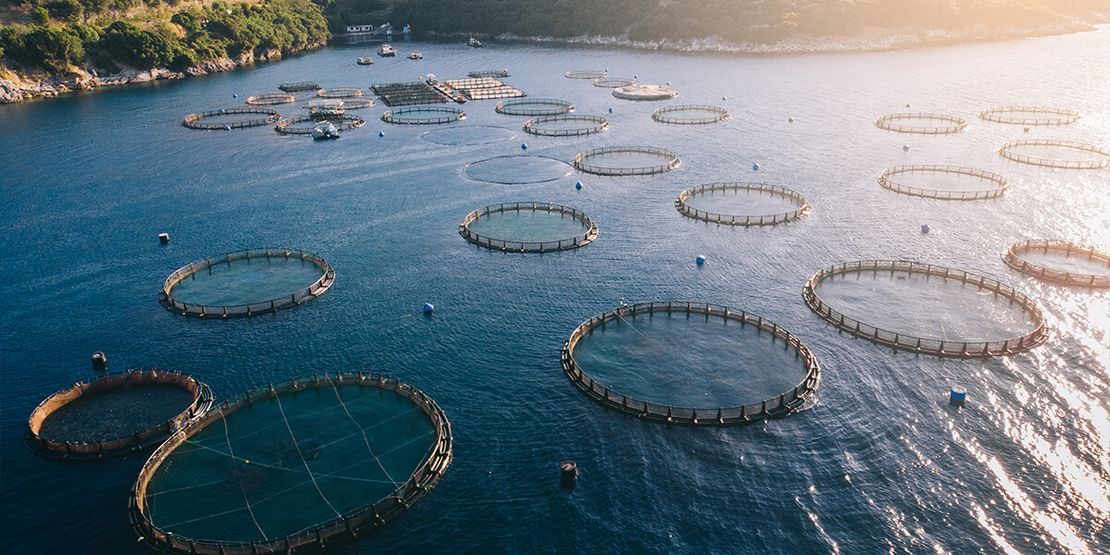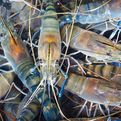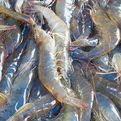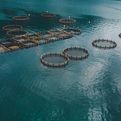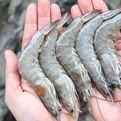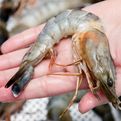Aquaculture Farming: Essential Terms and Definitions for Beginners (Part 2)
Abiotic Factors: Non-living environmental factors such as temperature, water quality, and salinity that impact the growth and health of shrimp.
Algal Bloom: Rapid growth of algae in a body of water, which can deplete oxygen levels and harm aquatic life.
Antibiotics: Medications used to treat bacterial infections in shrimp.
Aquaculture: The cultivation of aquatic plants and animals for human consumption.
Bacterial Disease: A type of illness caused by bacteria that affects the health of shrimp.
Biofloc Technology (BFT): A system that uses microorganisms to control water quality and reduce waste in shrimp ponds.
Carrying Capacity: The maximum number of shrimp that can be raised in a given area without causing environmental harm.
Chlorine: A chemical used to disinfect water in shrimp ponds.
Clarifier: A device that removes suspended solids and other pollutants from water.
Copepod: A tiny crustacean that is a common food source for shrimp.
Decapsulation: The removal of a shrimp’s protective exoskeleton.
Density: The number of shrimp per unit of water in a pond.
Diatomaceous Earth: A fine powder made from the fossilized remains of diatoms, used to filter water in shrimp ponds.
Disinfectant: A chemical used to kill pathogens in water and on surfaces.
Dissolved Oxygen: The amount of oxygen in water, which is critical for the survival of shrimp.
Effluent: Wastewater produced by shrimp farms.
Electro-fishing: The use of electrical current to stun and capture shrimp.
Exoskeleton: A hard outer shell that protects the body of a shrimp.
Feed: The food given to shrimp in aquaculture, typically a combination of dry pellets and live organisms.
Feed Conversion Ratio (FCR): The amount of feed needed to produce a unit of shrimp biomass.
Filter Feeder: A type of organism that feeds on small particles suspended in water.
Floating Net: A type of cage used to contain shrimp in open water.
Genetics: The traits and characteristics passed down from parents to offspring.
Hatchery: A facility where shrimp are raised from eggs to juveniles.
Intensive Farming: A type of aquaculture that uses high stocking densities and inputs of feed and water.
Juvenile Shrimp: Young shrimp that have reached the post-larval stage of development.
Larvae: The early stage of a shrimp’s life cycle.
Litigation: Legal action taken against a shrimp farm for environmental violations or other issues.
Maturation: The process of reaching sexual maturity in shrimp.
Metamorphosis: A change in form or structure during development.
Mortality: The rate of death among shrimp in a pond.
Nauplii: The earliest stage of a shrimp’s life cycle.
Nutrition: The balance of nutrients and energy in the diet of shrimp.
Organic Matter: Material of plant or animal origin in water.
Pathogens: Microorganisms that cause disease in shrimp.
Pellets: Dry, compacted feed that is fed to shrimp in aquaculture.
Ponds: A man-made body of water used for shrimp farming.
Rearing: The process of growing and raising shrimp to maturity.
Salinity: The concentration of salt in the water. Shrimp farming requires a specific level of salinity to ensure the proper growth and health of the shrimp.
Stocking Density: The number of shrimp in a pond, expressed as shrimp per unit area. The stocking density must be controlled to avoid overcrowding and disease.
Vaccination: The process of injecting a vaccine into shrimp to protect them from disease.
Water Exchange: The process of removing and replacing the water in a shrimp pond. Water exchange is important for maintaining proper water quality and temperature.
Water Quality: The physical, chemical, and biological properties of the water in a shrimp pond. The water quality must be maintained to ensure the health and growth of the shrimp.
Zooplankton: Microscopic organisms that serve as food for shrimp. Zooplankton is important for the growth and development of shrimp in a pond.
P: Pond - A man-made body of water used for shrimp farming.
Q: Quarantine - The process of isolating new shrimp stocks to prevent the spread of disease.
R: Recirculating aquaculture system (RAS) - A type of aquaculture system that filters and recycles water to minimize waste and conserve resources.
S: Shrimp - The main species farmed in aquaculture.
T: Total Dissolved Solids (TDS) - The amount of minerals, salts, and other substances dissolved in water that can affect water quality and shrimp health.
U: Upwelling - A natural phenomenon in which cold, nutrient-rich water rises from the ocean floor to the surface.
V: Vibrio - A type of bacteria commonly found in shrimp ponds and a common cause of shrimp disease.
W: Water exchange - The process of draining and refilling pond water to maintain water quality and prevent disease.
X: Xenobiotics - Chemical compounds or substances that are not naturally found in the environment and may have harmful effects on shrimp health and survival.
Y: Yellow Head Disease (YHD) - A shrimp disease caused by the Vibrio parahaemolyticus bacterium.
Z: Zooplankton - Tiny aquatic organisms that serve as a food source for shrimp in ponds.
Acute Hepatopancreatic Necrosis Disease (AHPND): A highly infectious and deadly shrimp disease caused by the bacterium Vibrio parahaemolyticus.
Adhesin: A protein or carbohydrate molecule that allows bacteria to attach to the surface of shrimp.
Amoebic Gill Disease (AGD): A shrimp disease caused by the parasite Neoparamoeba perurans, which infects the gills and impairs their function.
Antibiotic: A type of drug used to treat bacterial infections.
Bactericide: A substance that kills bacteria.
Bacterial Gill Disease (BGD): A shrimp disease caused by a bacterial infection of the gills.
Bacterial Vibriosis: A shrimp disease caused by the bacterium Vibrio, which can cause damage to the gills, digestive tract, and other organs.
Biofloc: A type of shrimp culture system that uses a combination of bacteria and microorganisms to control water quality.
Chemotherapy: The use of drugs to treat a disease, especially one caused by bacteria or other microorganisms.
Chloramphenicol: A type of antibiotic used to treat bacterial infections in shrimp.
Chitin: A type of carbohydrate found in the exoskeleton of shrimp and other crustaceans.
Chlorine: A chemical used as a disinfectant in shrimp aquaculture.
Coliform: A type of bacteria found in the digestive tract of animals, including shrimp.
Copper Sulfate: A chemical used as a disinfectant and algaecide in shrimp aquaculture.
Crustacean Pathogenic Mycobacterium (CPM): A type of bacterium that can cause disease in shrimp and other crustaceans.
Densovirus: A type of virus that can cause disease in shrimp.
Diatomaceous Earth: A type of sedimentary rock used as a filtration material in shrimp aquaculture.
Electron Microscopy: A type of microscopy that uses electrons to produce high-resolution images of cells and other structures.
Enteritis: An inflammation of the intestines, often caused by bacterial or viral infections.
Enzootic: A disease that is consistently present in a specific population of animals.
Epizootic: A disease that spreads rapidly through a population of animals.
Exopodite: A type of appendage found on the legs of shrimp and other crustaceans.
Feed: The food given to shrimp in aquaculture systems.
Feed Conversion Ratio (FCR): A measure of the efficiency of converting feed into shrimp biomass.
Filter Feeding: The process by which shrimp filter particles from the water for food.
Flocculant: A chemical used to remove suspended particles from water in shrimp aquaculture systems.
Formalin: A type of disinfectant used in shrimp aquaculture systems.
Frozen Shrimp: Shrimp that have been harvested, processed, and frozen for storage and transport.
Gills: The respiratory organs of shrimp and other aquatic animals.
Growth Promoters: Substances added to shrimp feed to improve growth and overall health.
Haemolymph: The fluid that circulates throughout the body of shrimp and
Haemolymphatic Nodules: A condition where small lumps appear on the shrimp’s body, usually as a result of a bacterial or viral infection.
Histophilosis: A disease caused by the bacterium Histophilus penaei, which affects the digestive tract and reproductive organs of shrimp.
HPWD (Heat-Preserving Water-Preserving Disease): A disease that is caused by the bacterium Photobacterium damselae subsp. damselae, which affects the gills and hindgut of shrimp, causing lethargy and death.
Infectious Hypodermal and Hematopoietic Necrosis (IHHN): A virus that causes yellow spots and ulcerations on the shrimp’s body, leading to death.
Infectious Myonecrosis Virus (IMNV): A virus that causes damage to the shrimp’s muscles, leading to death.
Luminous Bacterial Disease: A disease caused by the bacterium Vibrio harveyi, which affects the digestive tract of shrimp, causing them to emit a greenish glow.
Methylmercury Toxicity: A condition caused by the consumption of contaminated food, leading to the buildup of toxic levels of mercury in the shrimp’s body.
Nodavirus: A virus that causes white spots on the shrimp’s body, leading to death.
Parasitism: A disease caused by parasites such as copepods, isopods, and leeches that feed on the shrimp’s body, leading to death.
Perkinsosis: A disease caused by the parasite Perkinsus marinus, which affects the gills and digestive tract of shrimp, leading to death.
Peroxidase Deficiency: A condition where the shrimp is unable to produce a key enzyme, leading to a decrease in immunity and increased susceptibility to disease.
P: PAPA Syndrome - A shrimp disease caused by the bacterium Vibrio parahaemolyticus and characterized by skin damage, muscle necrosis, and digestive tract damage.
Q: Q Fever - A shrimp disease caused by the bacterium Coxiella burnetii and characterized by systemic symptoms such as abdominal pain, fever, and malaise.
R: Red Necrosis Syndrome - A shrimp disease caused by the bacterium Vibrio harveyi and characterized by red discoloration and necrosis of the shrimp’s body.
S: Summer Mortality Disease - A shrimp disease caused by multiple factors such as high water temperature, high density of shrimp, poor water quality, and stress from disease and overcrowding.
T: Taura Syndrome - A shrimp disease caused by the virus Taura Syndrome Virus (TSV) and characterized by stunted growth, shell deformities, and reduced survival rate.
U: Ulcerative Disease - A shrimp disease caused by the bacterium Vibrio owensii and characterized by necrotic lesions and ulcers on the shrimp’s body.
V: Vibriosis - A shrimp disease caused by the bacterium Vibrio spp. and characterized by skin damage, muscle necrosis, and digestive tract damage.
W: White Spot Syndrome Virus (WSSV) - A shrimp disease caused by the virus White Spot Syndrome Virus (WSSV) and characterized by white spots on the shrimp’s body and reduced survival rate.
X: Xanthomonas - A shrimp disease caused by the bacterium Xanthomonas spp. and characterized by skin damage, digestive tract damage, and reduced survival rate.
Y: Yellow Head Disease - A shrimp disease caused by the virus White Spot Syndrome Virus (WSSV) and characterized by yellow discoloration and necrosis of the shrimp’s head.
Z: Zonal Necrosis - A shrimp disease caused by the bacterium Vibrio penaeicida and characterized by discoloration and necrosis of the shrimp’s body in distinct zones.
P: Pathogen - A disease-causing organism that can infect and harm shrimp.
Q: Quorum Sensing - A process in which bacteria communicate and coordinate their behavior through chemical signaling.
R: Red Tide - A phenomenon that occurs when a large amount of harmful algae bloom, causing significant harm to marine life, including shrimp.
S: Septicemia - A severe bacterial infection that spreads throughout the shrimp's bloodstream, causing organ damage and death.
T: Taura Syndrome - A lethal shrimp disease that was first identified in the early 1990s in the Americas.
U: Uropodal Cuticle - The protective outer layer of a shrimp's tail.
V: Vibrio - A genus of bacteria that can cause various diseases in shrimp, including vibriosis and luminescent vibriosis.
W: White Spot Syndrome Virus (WSSV) - A highly contagious and deadly virus that affects shrimp, causing white spot lesions on their bodies.
X: X-Ray Fluorescence - A technique used to analyze the chemical composition of shrimp and detect the presence of disease-causing pathogens.
Y: Yellow Head Disease - A highly contagious and lethal virus that affects shrimp, causing yellow discoloration on their heads and bodies.
Z: Zoonosis - A disease that can be transmitted from animals to humans. Some shrimp diseases, such as vibriosis, have the potential to cause zoonosis.
—
AC Current: Alternating current that is commonly used in electric motors and electrical appliances.
Circuit Breaker: A safety device used to prevent electrical overloading by automatically switching off power to a circuit.
DC Current: Direct current that is used in battery-powered systems, solar panels, and in some industrial processes.
Ground: A conductor that is connected to the earth to protect against electrical shocks and ground faults.
Ground Fault Circuit Interrupter (GFCI): A safety device that interrupts electrical power when it detects an imbalance in the current between the hot and neutral wires.
Inverter: A device that converts DC current into AC current, allowing for use of AC powered devices in a DC powered system.
Load: The electrical power consumption of an appliance or system.
Panelboard: An electrical panel that contains the main breaker and circuit breakers for a building or system.
Power Supply: The source of electrical power for an appliance or system.
Voltage: The measure of electrical potential difference between two points, often measured in volts.
Wiring: The process of installing and connecting electrical conductors in a system.
Ampere: The unit of electric current, often used to measure the flow of electricity in a circuit.
Ohm: The unit of electrical resistance, used to measure the opposition of a material to the flow of electrical current.
Watt: The unit of power, used to measure the rate of energy transfer in an electrical system.
Waterproof Electrical Connectors: Special connectors designed to prevent water from entering electrical systems and causing damage or electrical shock
Riley Sinclair (Digital Aqua Bear)
Hi! I'm Riley Sinclair (Digital Aqua Bear), and I'm exploring the world of digital aquaculture farms. Join me as I delve into innovative methods and sustainable practices for cultivating aquatic life in digital environments. Let's uncover the potential of digital aquaculture farms to revolutionize food production and environmental sustainability.
More From Digital Aqua Farm
Algae Bloom in Shrimp Farming: Strategies for Detection, Prevention, and Solution
Riley Sinclair (Digital Aqua Bear)
Global Shrimp Industry: Knowing the Key Players and Dynamics
Riley Sinclair (Digital Aqua Bear)
Artificial Intelligence in Shrimp Farming: A New Era of Innovation
Riley Sinclair (Digital Aqua Bear)
Aquaculture Farming: Essential Terms and Definitions for Beginners (Part 3)
Riley Sinclair (Digital Aqua Bear)
Digital Aqua Farming Success: The Role of Business Intelligence for Shrimp Farmers
Riley Sinclair (Digital Aqua Bear)
Motors in Shrimp Farming: Choosing Between With and Without Inverters
Riley Sinclair (Digital Aqua Bear)


